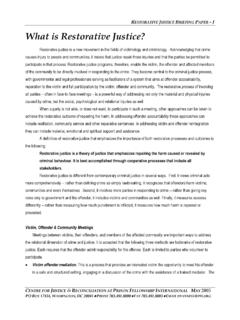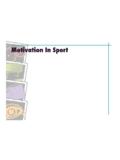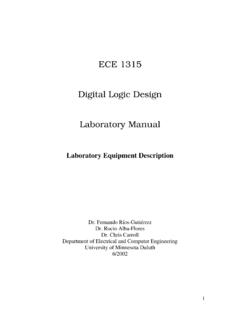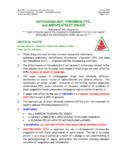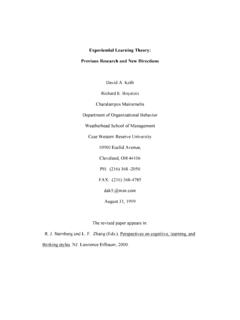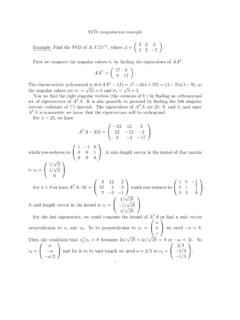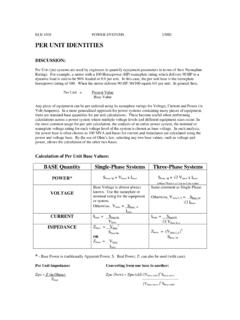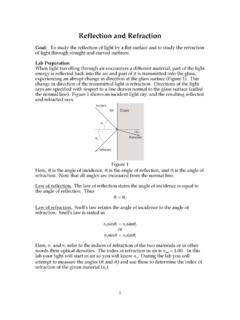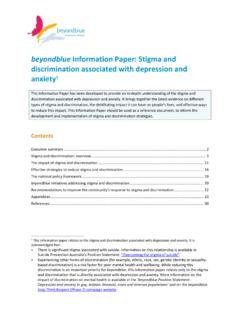Transcription of JOURNAL OF RESEARCH IN CRIME AND DELINQUENCYAgnew ...
1 JOURNAL . Agnew / GENERAL. OF RESEARCH . STRAININTHEORY. CRIME AND DELINQUENCY. BUILDING ON THE FOUNDATION. OF GENERAL STRAIN THEORY: SPECIFYING THE TYPES OF. STRAIN MOST LIKELY TO LEAD. TO CRIME AND DELINQUENCY. ROBERT AGNEW. General strain theory (GST) is usually tested by examining the effect of strain on CRIME . Researchers, however, have little guidance when it comes to selecting among the many hundreds of types of strain and have trouble explaining why only some of them are related to CRIME . This article builds on GST by describing the characteristics of strainful events and conditions that influence their relationship to CRIME . Strains are said to be most likely to result in CRIME when they (1) are seen as unjust, (2) are seen as high in magnitude, (3) are associated with low social control, and (4) create some pressure or incentive to engage in criminal coping.
2 Drawing on these character- istics, it is predicted that some types of strain will not be related to CRIME , including types that have dominated the RESEARCH on strain theory, and that others will be related to CRIME , including types that have been neglected by empirical researchers. General strain theory (GST) argues that strains or stressors increase the likelihood of negative emotions like anger and frustration. These emotions create pressure for corrective action, and CRIME is one possible response (Agnew 1992). CRIME may be a method for reducing strain ( , stealing the money you desire), seeking revenge, or alleviating negative emotions ( , through illicit drug use).
3 GST builds on previous strain theories in several ways: most notably, by pointing to several new categories of strain, including the loss of positive stimuli ( , loss of a romantic partner, death of a friend), the presentation of negative stimuli ( , physical assaults and verbal in- sults), and new categories of goal blockage ( , the failure to achieve justice goals). Recent RESEARCH demonstrates that many of the specific strains falling under these categories are related to CRIME and delinquency (see Agnew 2001a for a summary; Aseltine, Gore, and Gordon 2000; Mazerolle et al. 2000; Piquero and Sealock 2000). The specification of these new categories of strain is GST's greatest strength.
4 JOURNAL OF RESEARCH IN CRIME AND DELINQUENCY, Vol. 38 No. 4, November 2001 319-361. 2001 Sage Publications 319. 320 JOURNAL OF RESEARCH IN CRIME AND DELINQUENCY. This strength, however, is also GST's biggest weakness. GST is so broad that researchers have little guidance as to the specific types of strain to exam- ine in their RESEARCH . Hundreds of types of strain fall under the major catego- ries of strain listed by GST, as reflected in recent inventories of stressful life events, chronic stressors, and daily life events or hassles (see Cohen, Kessler, and Gordon 1995; Herbert and Cohen 1996 for overviews). And even these inventories do not measure many of the strains described by GST.
5 Further- more, the broadness of GST makes it difficult to falsify. As Jensen (1995). stated, if strain can be defined in so many different ways, then strain theory is virtually unfalsifiable. There is always a new measure that might salvage the theory (p. 152). It is therefore crucial that GST more precisely specify the types of strain most likely to lead to CRIME and delinquency. This article represents an attempt to do that. First, strain is defined. Although Agnew (1992) presented a general definition of strain, the term has nevertheless been used in different ways by researchers and it is important to clarify its meaning. Second, previ- ous tests of GST are reviewed to determine what they say about the types of strain most likely to lead to CRIME .
6 Third, the characteristics of those types of strain most likely to lead to CRIME are described. Briefly, such strains (1) are seen as unjust, (2) are seen as high in magnitude, (3) are associated with low social control, and (4) create some pressure or incentive to engage in CRIME . Fourth, these characteristics are then used to predict the likelihood that sev- eral types of strain will result in CRIME . Fifth, suggestions for empirical RESEARCH are provided. WHAT IS STRAIN? Before discussing the types of strain most likely to lead to CRIME , it is first necessary to clarify what is meant by the term strain. Agnew (1992) stated that strain refers to relationships in which others are not treating the individ- ual as he or she would like to be treated (p.)
7 48). Even so, researchers use the term in different ways. Some refer to an objective event or condition ( , the infliction of physical abuse, the receipt of poor grades at school), some to the individual's evaluation of an event or condition ( , whether juveniles like the way their parents or teachers treat them), and some to the emotional reaction to an event or condition ( , whether respondents are angry at how others treat them). To help clarify the meaning of strain, the following defini- tions are proposed. Objective strains refer to events or conditions that are disliked by most members of a given group. So, if we state that an individual is experiencing objective strain, we mean that he or she is experiencing an event or condition Agnew / GENERAL STRAIN THEORY 321.
8 That is usually disliked by members of his or her group. Many events and con- ditions are disliked by most people, regardless of group membership ( , physical assault, lack of adequate food and shelter). The evaluation of other events and conditions varies with group characteristics, such as gender and age ( , Broidy and Agnew 1997; Elder, George, and Shanahan 1996). It is, of course, important for researchers to consider the possibility of such group differences when constructing measures of objective strain. Empirically, it is possible to determine the objective strains for group members in several ways. Observational RESEARCH is one method.
9 Anderson (1999), for example, described many of the objective strains in a poor, inner-city, African American community. Surveying a representative sample of group members or people familiar with the group is another method, and both have been employed in the stress RESEARCH (Turner and Wheaton 1995). In particular, respondents can be asked whether they (or group members). would dislike a range of events and conditions. It is important to present respondents with preestablished lists of events/conditions and to ask them to list events/conditions not on the list. This helps to ensure that a complete list of objective strains is Subjective strains refer to events or conditions that are disliked by the peo- ple who are experiencing (or have experienced) them.
10 So, if we state that indi- viduals are experiencing subjective strain, we mean that they are experienc- ing an event or condition that they dislike. One of the key findings to emerge from the stress RESEARCH is that individuals often differ in their subjective eval- uation of the same objective strains. For example, people differ in how they subjectively evaluate such objective strains as divorce and the death of a fam- ily member. The subjective evaluation of an objective strain is a function of a range of factors, including individual traits ( , irritability), personal and social resources ( , self-esteem, self-efficacy, social support), goals/values/.
